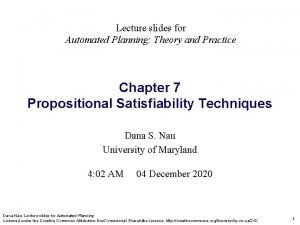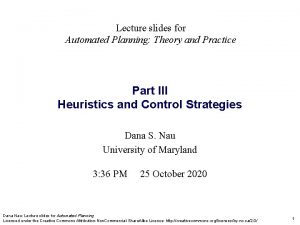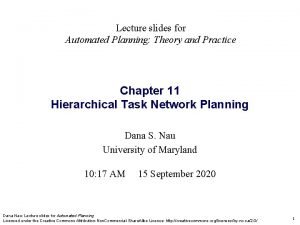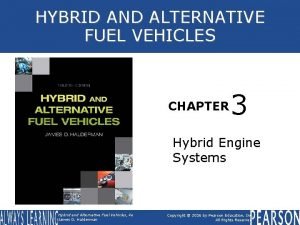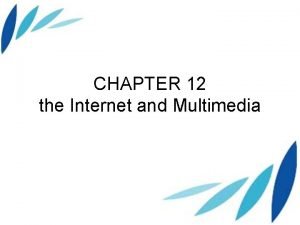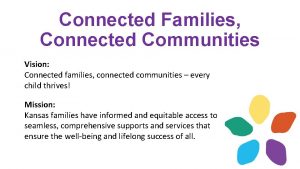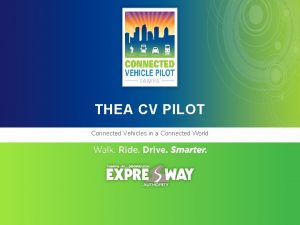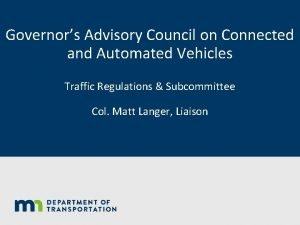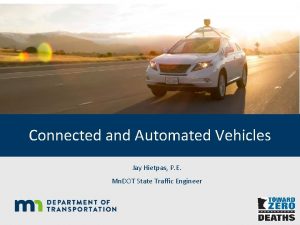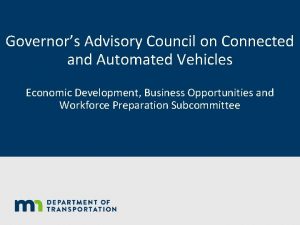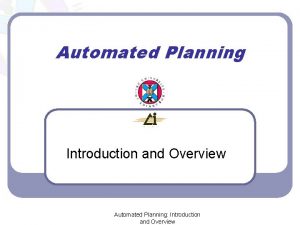ROLE OF CONNECTED AND AUTOMATED VEHICLES IN PLANNING











- Slides: 11

ROLE OF CONNECTED AND AUTOMATED VEHICLES IN PLANNING USDOT 5 th ITS PCB University Workshop November 2017

Role of Connected and Automated Vehicles in Transportation Planning Recent CV/AV Planning Research Projects Ø Incorporating CV/AV in Transportation Planning Processes and Products Ø Scenario Planning for Connected and Automated Vehicles

Incorporating Connected/Automated Vehicles in Transportation Planning Purpose of the Study The study aimed to help facilitate the consideration of C/AV in transportation planning processes and products by States, MPOs and local agencies by reviewing: 1) 2) 3) 4) Impacts on planning processes and products Impacts on roles and responsibilities Impacts on tools, techniques and data Impact on organizational skills and expertise

Impacts on Processes General Considerations Ø Understand the technology and its dimensions Ø Track technology advancements Ø Understand market penetration & efficacy rates for technology and applications Ø Forge partnership with new stakeholders Ø Utilize ITS approach as a platform for incorporating C/AV in planning processes Ø Incorporate Dedicated Short Range Communication (DSRC) into arterial and intersection improvement projects and for data gathering Ø Consider data collection opportunities that require small smart technology market penetration Ø Plan to manage “Big Data” Long Term impacts: Ø Incorporate potential changes in physical infrastructure requirements Ø Considerate shortened project life cycles with more focus on communications Ø Prepare for rapid technology changes Ø Prepare for change in travel behavior & travel patterns and thereby on transportation planning tools and models Ø Plan for multifaceted fleet composition Ø Consider potential impact on transportation, land use, and economy

Impacts on Roles and Responsibilities Summary of Recommendations New stakeholders Ø Communications companies Ø Vendors of C/AV equipment and systems Ø Vendors providing data management and analytical services Ø Companies that will provide security Ø Educational institutions Ø New niche organizations that have not yet emerged New Expertise Ø Data analyst and data “scientist” to manage “Big Data” Ø Hardware, software and communications technology specialists Ø Potential shift of analytical responsibilities from the public sector to the private sector

Impacts on Tools, Techniques and Data Factors to consider in evaluating the effectiveness of tools Ø Levels of automation Ø Market penetration Ø Efficacy rates Ø Impact on fleet composition Ø Availability of empirical data representing gains in capacity, delay, travel time, speed, and emissions under different market penetration rates Tools must be revisited and revised to account for Ø Changes in infrastructure criteria Ø Changes in driver behavior Ø New capabilities

Deliverables Impact on planning processes and products http: //ntl. bts. gov/lib/55000/55711/FHWA-JPO-16 -246. pdf Impact on tools, techniques and data http: //ntl. bts. gov/lib/55000/55712/FHWA-JPO-16 -247. pdf 11 illustrative case studies Workforce skills and Training http: //ntl. bts. gov/lib/59000/59173/FHWA-JPO-16 -364. pdf Primer Outreach materials § Highway Capacity Manual Tech Memo http: //ntl. bts. gov/lib/59000/59316/FHWA-JPO-16 -365. pdf § Modeling Tech Memo http: //ntl. bts. gov/lib/59000/59249/FHWA-JPO-16 -412. pdf § § Planning Community Outreach Tech Memo Desk Reference

Scenario Planning for Connected and Automated Vehicles Background Ø Scenario planning is a tool used by planner to develop plausible futures and highlights major forces that can shape the future Ø Helps decision makers to prepare for tomorrow Purpose of the Study Ø Develop several futures Ø Document and describe the process for conducting CV / AV scenario planning

Scenario Planning for Connected and Automated Vehicles Scope Ø Technology scan Ø Scenario planning workshops Ø Workshop #1 on technology Ø Workshop #2 - Testing Scenario Implications Ø Policy implications Ø Outreach materials Schedule Ø This study was initiated in December 2016 and will be completed in spring 2018.

Scenario Planning for Connected and Automated Vehicles Workshops 1 Ø Ø Conduct in August 2017 Panel of Experts Target Year 2035 Focused on Emerging Technology Ø Automation Ø Connectivity Ø Cooperation Ø Developed 6 Scenarios Ø Drivers – External Forces (Market Actions, Consumer Preferences, Innovation) Ø Levers - Internal Actions (Public policies, Infrastructure Investment, Subsidies, Restrictions)

Six Potential CV/AV Scenarios Developed in Workshop #1
 Balanced delta-wye connection
Balanced delta-wye connection 3 phase power formula
3 phase power formula In a ∆-connected source feeding a y-connected load
In a ∆-connected source feeding a y-connected load Automated planning theory and practice
Automated planning theory and practice Automated planning theory and practice
Automated planning theory and practice Automated planning theory and practice
Automated planning theory and practice What is web role and worker role in azure
What is web role and worker role in azure Poem about momentum and impulse
Poem about momentum and impulse Fuel pressure regulator diagram
Fuel pressure regulator diagram Plugins and delivery vehicles in multimedia
Plugins and delivery vehicles in multimedia Nascar motors assembles and sells
Nascar motors assembles and sells Krappmann modell
Krappmann modell



